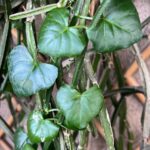As the summer progresses and the heat outside makes it difficult for us GULF gardeners to work outside, I have turned my attention to learning about indoor plants. My home is heavily curtained and does not receive much light, but I have some spaces which have bright indirect light during the day which I have devoted to my indoor plant collection.
As I continue with my experiments with indoor plants, I would like to introduce you to Alocasia Polly. It is a pretty plant and does really well indoors as a houseplant. Alocasia varieties are gorgeous tropical plants with arrowhead-shaped leaves. They are native to the islands in the South Pacific, particularly The Philippines and enjoy warm, tropical weather with humidity. They will do well here indoors all through the year as long as you can give them enough humidity and bright indirect light and keep them away from the AC blast. However as always, come October my Alocasia will go and live outdoors in the shade as it does not like direct sun. It should do really well then as the winter in the UAE is fine in the winter and the temperature is conducive to growth. Alocasia plants grow from bulbs, so even if they lose all of their leaves, the stored energy in their bulbs allows them to sprout new leaves under the right conditions.

The Alocasia Polly is a variety of the hybrid Alocasia Amazonica. Alocasia X Amazonica is a hybrid produced by crossing two other Alocasia species: Alocasia watsoniana (which is now more correctly known as Alocasia longiloba ‘Watsoniana’) and Alocasia sanderiana. It was bred in the 1950s by Salvadore Mauro, a Florida greenhouse grower who owned the (now defunct) Amazon Nursery and named the new hybrid after his business. However neither of its grandparents came from the Amazon. They are from Southeast Asia and the Philippines respectively.
It truly is a beautiful plant and very easy to recognize from its leathery-looking leaves. The foliage, which sprouts from a central corm, is quite dramatic: arrow-shaped and very dark green with lighter, creamy green midribs. What makes ‘Polly’ different from its parent, Alocasia x Amazonica, is its size. It is much more compact and is well suited as a tabletop plant in your home, unlike most elephant ear varieties that can grow to 3.5 feet and upwards. For more details on the different hybrids bred please go to https://www.gardenbetty.com/alocasia-polly/#:~:text=Alocasia%20amazonica%20’Polly’%20is%20a,most%20popular%20Alocasia%20grown%20indoors..
The Alocasia Polly as I mentioned before likes a warm humid environment and a well-draining soil with bright indirect light. Lack of light or cold dry conditions can make it go dormant but if you are careful not to overwater and the bulb stays firm it will come back when the conditions are ideal. I have potted my Polly in the PON substrate which should take care of the fertilizer as well. I will share a video soon about that once the plant takes hold. Otherwise, a mixture of potting soil with perlite and a slow-release fertilizer should do the trick. Using a substrate ideal for cacti or succulents also works. The issue as always with most indoor plants is overwatering so make sure you check the soil and water only when the top two inches or so of the soil is dry or use a moisture meter. It likes humidity so misting regularly, grouping with other plants, and keeping a saucerful full of water with pebbles nearby normally works.
Fertilize with a balanced 20-20-20 fertilizer once a month when indoors, but from experience, you can do a bit more during the winter months in the GULF if you are placing it outdoors. In other regions please do not fertilize in winter as it is dormant then. If it goes dormant reduce watering and do not fertilize but do not let the soil dry out.
Common pests are Scale insects, mealybugs, and Aphids. Treat them quickly and effectively as they tend to spread among your houseplants quite rapidly. If your Alocasia Polly is already weakened by lack of light or insufficient watering the pests will cause yellowing leaves and general debility so keep an eye out for that.
PRO TIP: Make sure your watering is consistent and just enough. Improper watering can cause the plant to weaken and attract pests.
Only be careful, if you have curious toddlers, dogs, and cats who get into your plants as the plant contains calcium oxalate crystals which are mildly toxic.







Recent Comments